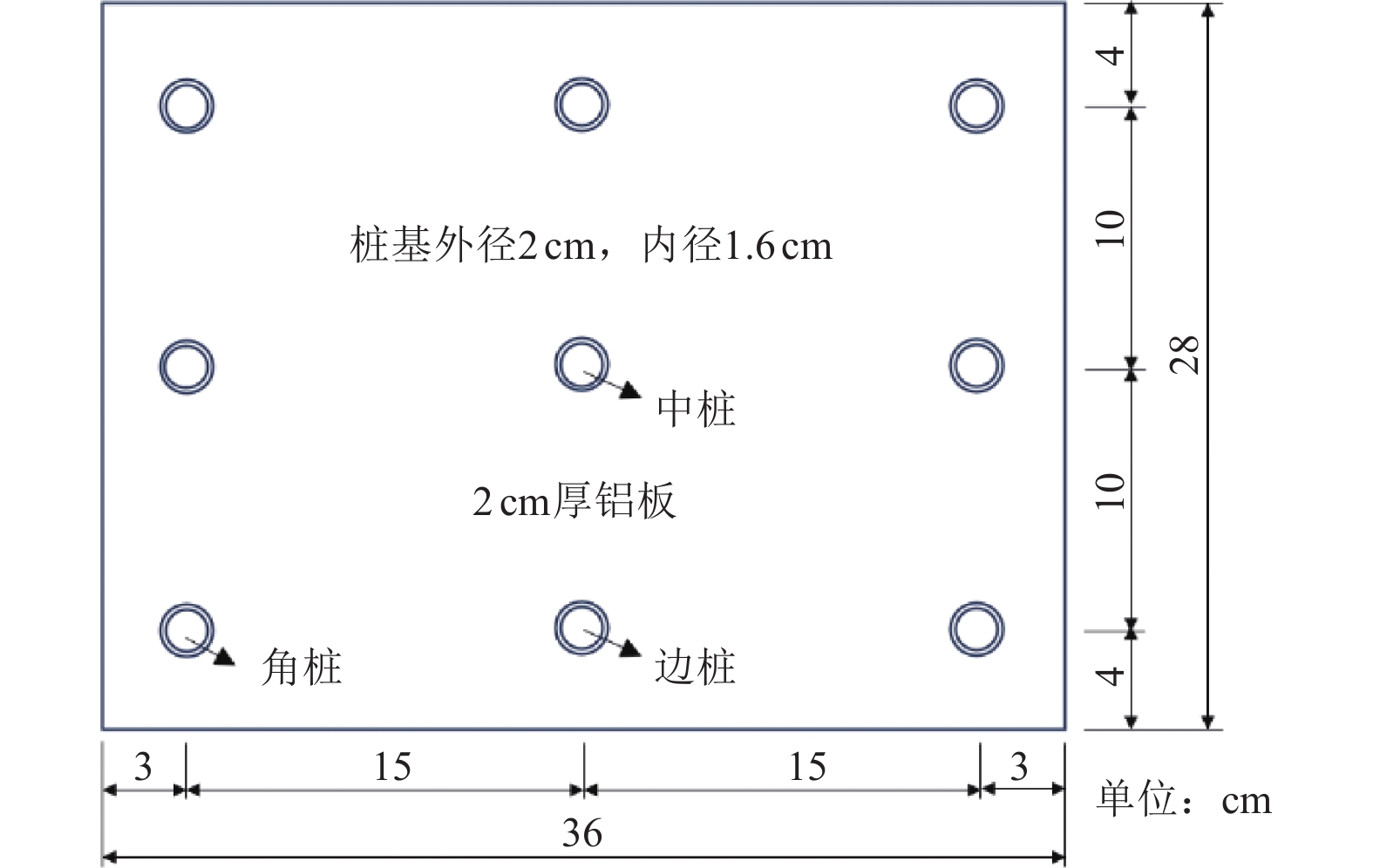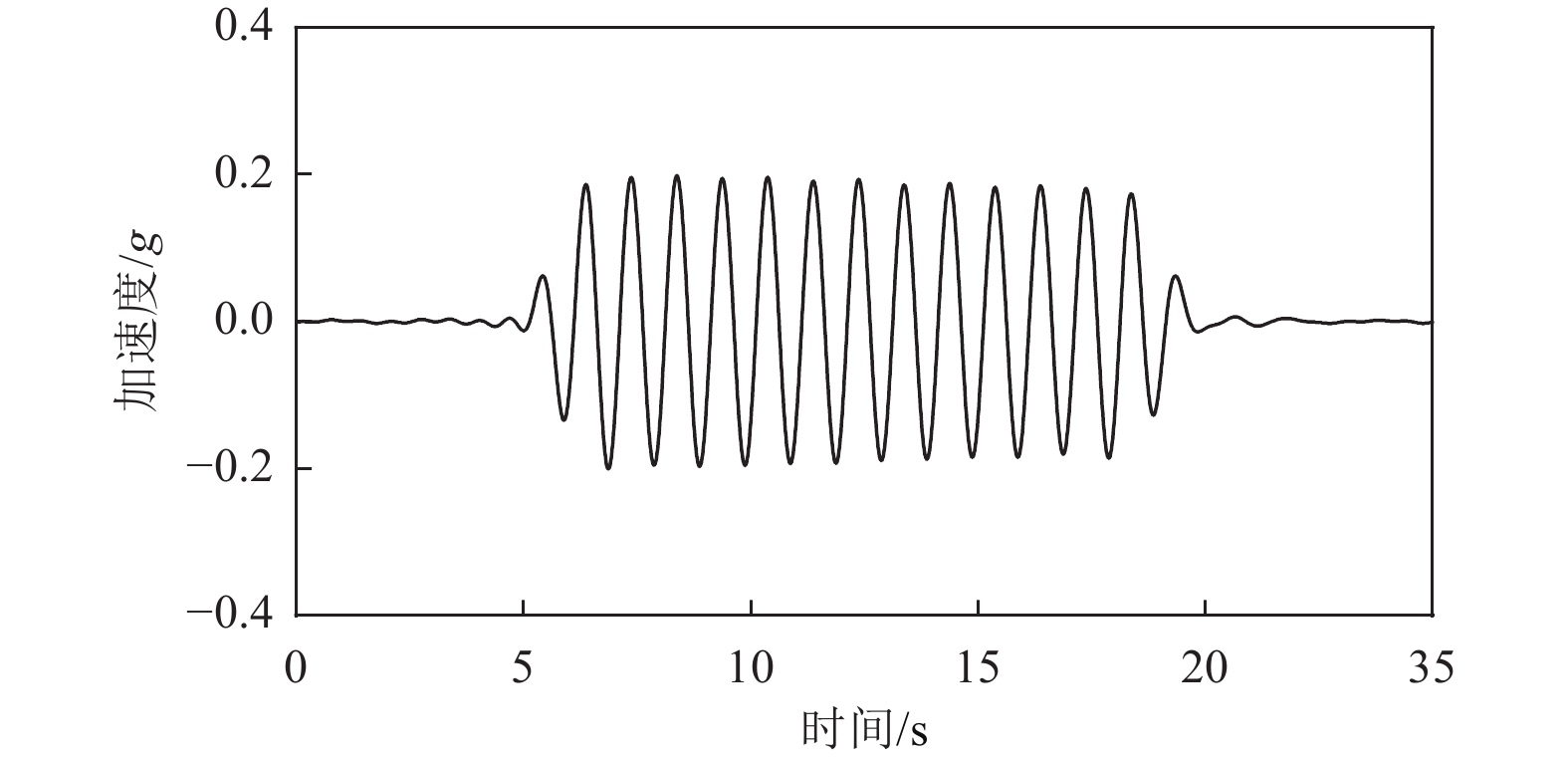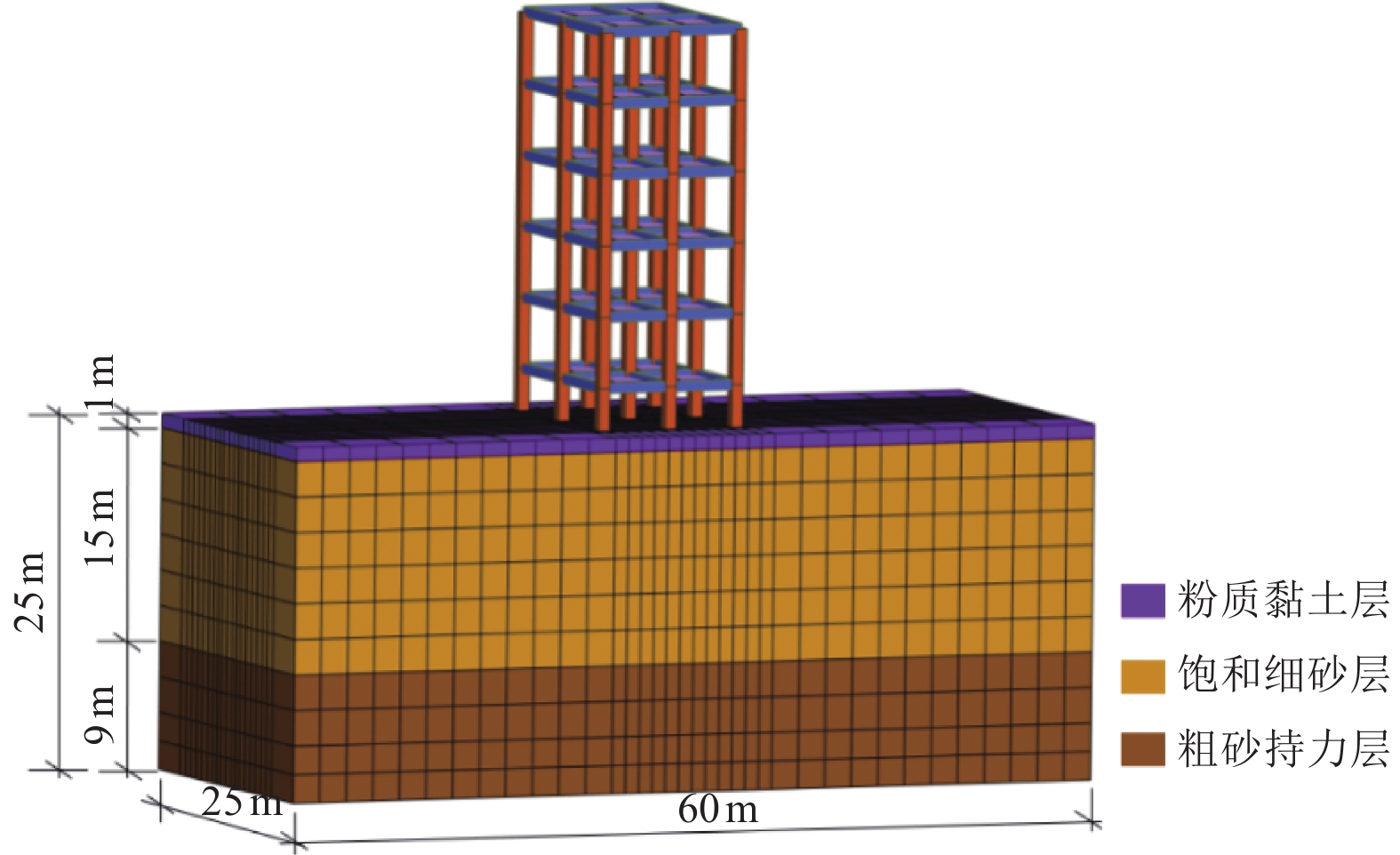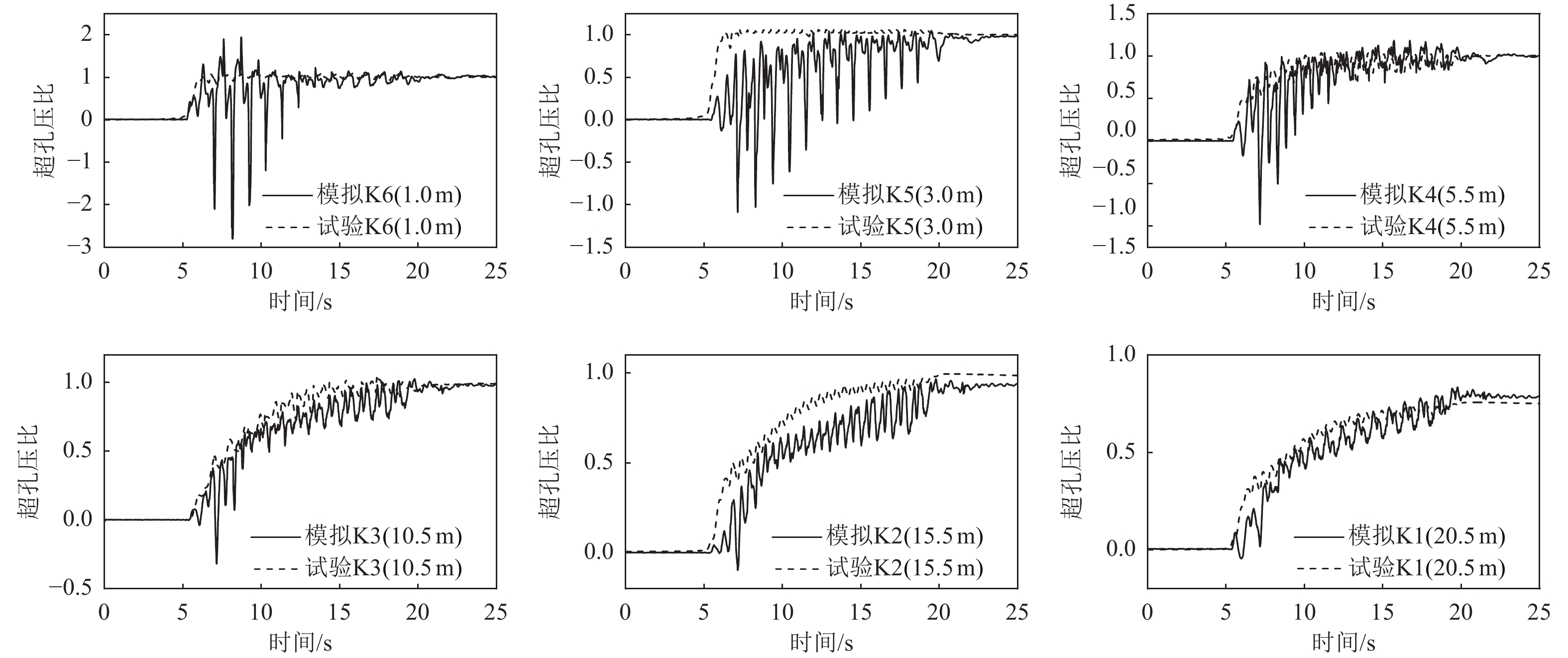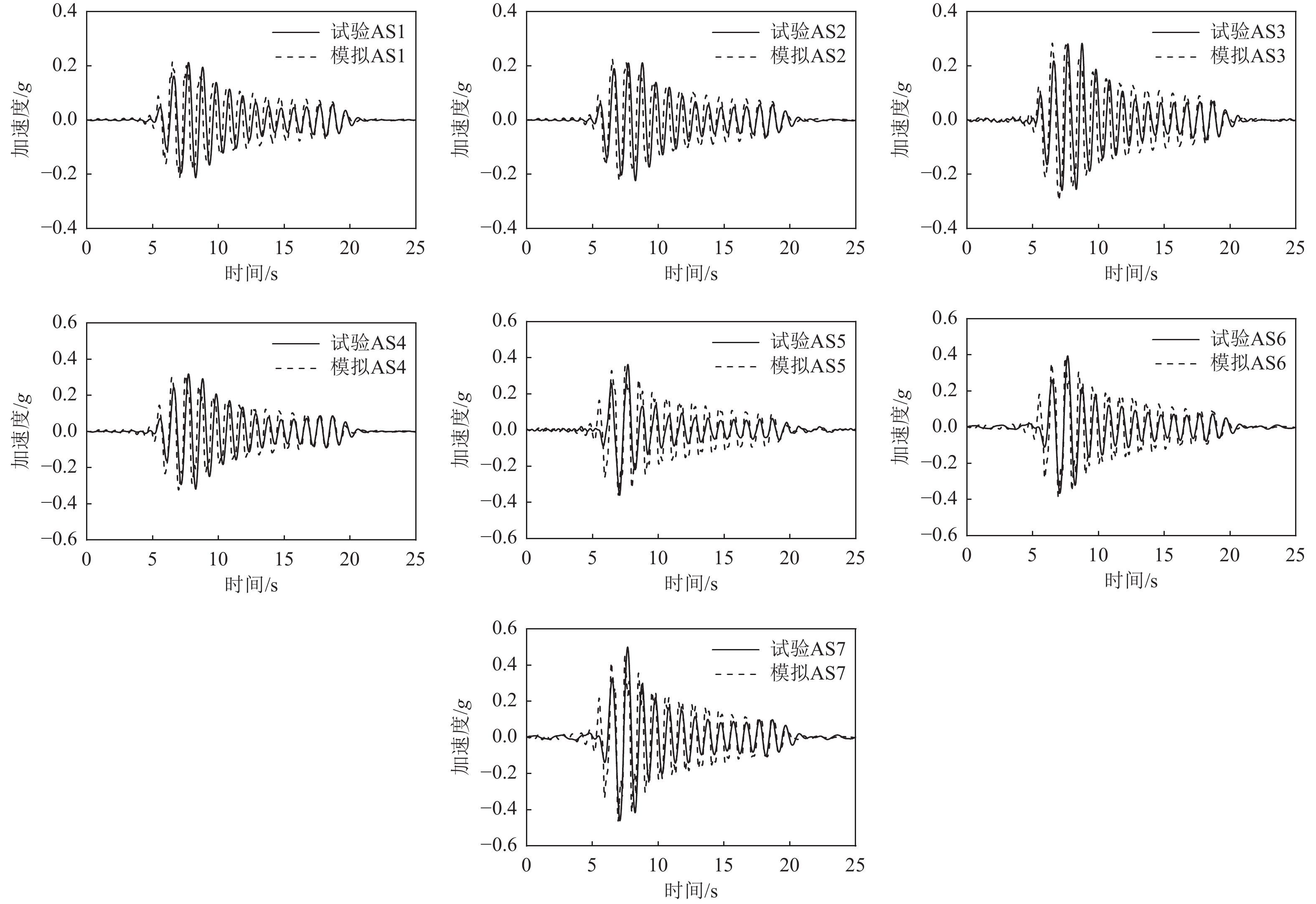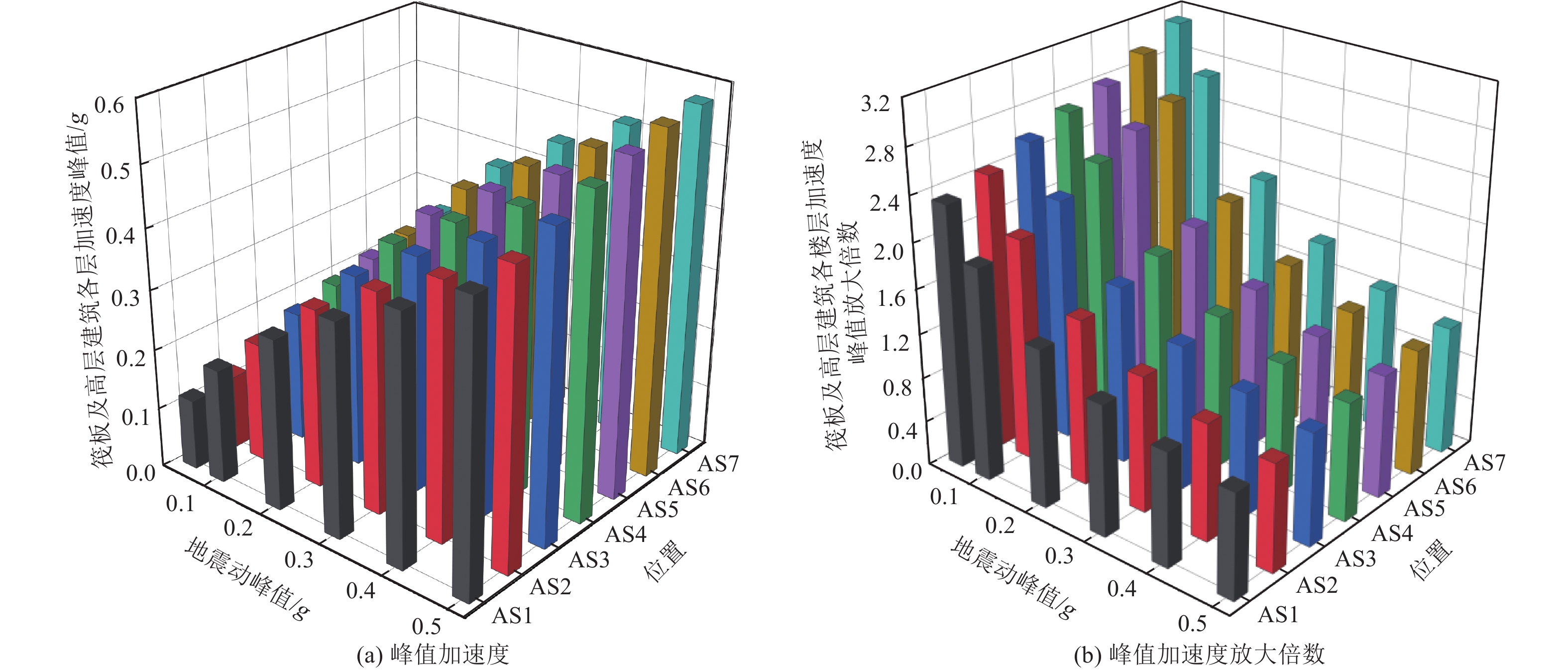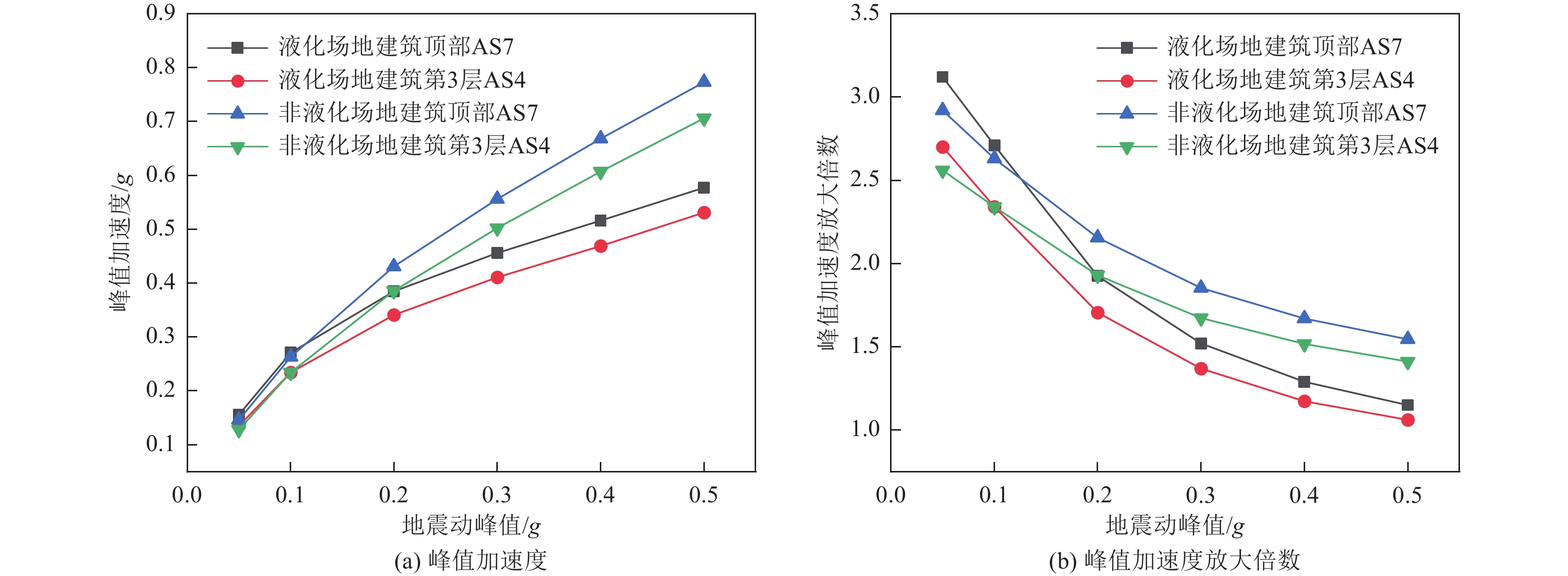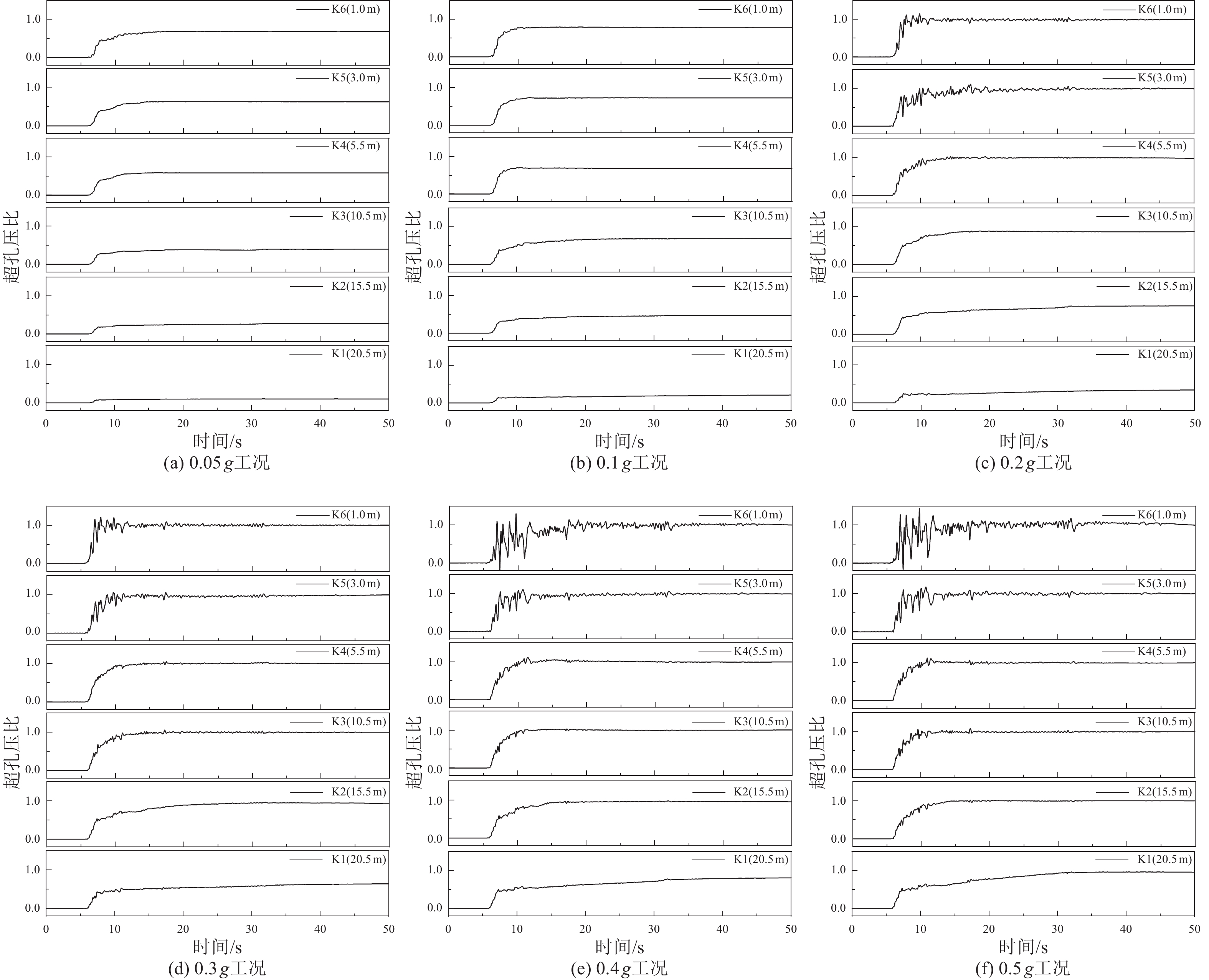Research on Dynamic Response of Pile-raft Foundation of High-rise Building Structures in Liquefiable Sites Under Seismic Action
-
摘要: 液化场地下高层建筑桩基抗震性能一直是防灾减灾工程中的热点问题,本文通过开展液化场地-桩筏基础-高层建筑结构体系动力响应大型离心机振动台试验,并基于STKO软件建立三维数值模型,通过对比土体超孔压比、土体加速度、上部建筑结构加速度和桩基弯矩等,验证数值模型的正确性和有效性;基于已验证的数值模型,输入不同峰值加速度的El Centro地震波,探究地震动强度对高层建筑桩筏基础的动力响应影响。结果表明,在相同地震波工况下,随着楼层的升高,楼层峰值加速度、最大位移逐渐增大,同时楼层峰值加速度放大倍数不断增加;在相同楼层处,随着地震动峰值的增加,楼层峰值加速度不断增大,楼层最大位移逐渐增大,但楼层峰值加速度放大倍数不断减小;小震作用下,土体并未发生液化,随着地震波峰值的增加,超孔压比上升的速度也随之加快,且土体超孔压比的波动程度随着地震动峰值的增加而变大;在小震作用下,桩身顶部会出现弯矩较大值,随着地震动峰值的增加,桩身弯矩峰值点位置下移,大震作用下,角桩、边桩及中桩的桩弯矩峰值均出现在液化层与非液化层交界处附近。Abstract: The seismic performance of pile foundations for high-rise buildings on liquefiable ground remains a critical issue in disaster prevention and mitigation engineering. To investigate this, a large-scale centrifuge shaking table test was conducted on the dynamic response of a liquefiable ground–pile raft foundation–high-rise building system. A three-dimensional numerical model was then established using STKO software. By comparing the soil excess pore water pressure ratio, soil acceleration, structural acceleration, and pile foundation bending moment, the accuracy and reliability of the numerical model were verified. Based on the validated model, El-Centro seismic waves with different peak accelerations were applied to examine the influence of ground motion intensity on the dynamic response of pile–raft foundations for high-rise buildings. The results indicate that: (1) under identical seismic wave conditions, both peak floor acceleration and maximum floor displacement increase with building height, while the peak acceleration amplification factor of floors also rises; (2) at the same floor level, increasing ground motion intensity leads to higher peak acceleration and maximum displacement, but a decreasing acceleration amplification factor; (3) under small earthquakes, the soil does not liquefy, but the excess pore water pressure ratio grows at an accelerating rate with increasing ground motion intensity, and its fluctuation amplitude also increases; (4) under small earthquakes, large bending moments occur at the pile head, and as ground motion intensity increases, the peak bending moment shifts downward along the pile shaft; (5) under large earthquakes, the peak bending moments of corner, edge, and central piles occur near the interface between liquefiable and non-liquefiable soil layers.
-
表 1 高层建筑原型基本信息
Table 1. Basic information for high-rise building
参数 数值 层数 6 层质量/t 283.25 总质量/t 1699.5 各层高度/m 5 结构自振周期/s 振型1 1.42 振型2 1.28 振型3 1.09 阻尼比 5% 桩长/m 19 桩数/根 9 筏板尺寸 18 m×14 m×1 m 楼板尺寸 15 m×10 m×0.1 m 表 2 离心机模型原型的相似比
Table 2. Scaling laws of the centrifuge model to the prototype
分项内容 相似比(模型/原型) 分项内容 相似比(模型/原型) 加速度 50∶1 应力 1∶1 时间 1∶50 应变 1∶1 长度 1∶50 位移 1∶50 密度 1∶1 集中力 1∶502 黏聚力 1∶1 力矩 1∶503 表 3 试验模型基本信息
Table 3. Basic information of the test model
参数 层高/cm 楼板厚度/cm 楼板质量/kg 筏板厚度/cm 筏板质量/kg 取值 100 0.25 2.3 2 5.44 表 4 天津砂物理参数
Table 4. Physical parameters of Tianjin sand
比重 最大孔隙比 最小孔隙比 内摩擦角/(°) 平均粒径/m 不均匀系数 2.642 0.943 0.603 36 0.00018 1.7 表 5 数值模型土层参数
Table 5. Soil layer parameters in numerical model
模型参数 粗砂层 细砂层 粉质黏土层 密度ρ/(kg·m−3) 2.1×103 2.0×103 1.5×103 参考剪切模量Gr/kPa 1.3×105 1.1×105 6×104 参考体积模量Br/kPa 2.6×105 2.4×105 3×105 摩擦角φ/(°) 37 35 0 峰值剪应变γmax 0.1 0.1 0.1 参考围压Pr/kPa 101 101 100 围压系数n 0.5 0.5 0 相位转换角φPT/(°) 26 26 — 剪缩参数c1 0.013 0.028 — 剪缩参数c3 0 0.05 — 剪胀参数d1 0.3 0.1 — 剪胀参数d3 0 0.05 — 屈服面数 20 20 20 初始孔隙比 0.50 0.65 — 黏聚力c/kPa 0 0 37 表 6 构件单元参数
Table 6. Structure unit parameters in numerical model
参数 弹性模量E/GPa 剪切模量G/GPa 泊松比ν 密度ρ/(kg·m−3) 数值 68.9 26.5 0.3 2800 表 7 非液化场地土层参数
Table 7. Soil layer parameters of non-liquefiable sites
模型参数 松砂层 密砂层 密度ρ/(kg·m−3) 1.5×103 1.8×103 参考剪切模量Gr/kPa 6×104 1.5×105 参考体积模量Br/kPa 3×105 7.5×105 黏聚力c/kPa 37 75 峰值剪应变γmax 0.1 0.1 -
陈龙伟, 刘昊儒, 任叶飞等, 2024. 2023年2月6日土耳其双强震场地液化及其震害特征现场调查分析. 岩土工程学报, 46(7): 1541−1548.Chen L. W., Liu H. R., Ren Y. F., et al., 2024. In-situ investigation of site liquefaction and liquefaction-induced damages triggered by two strong Türkiye earthquakes on Feb. 6th, 2023. Chinese Journal of Geotechnical Engineering, 46(7): 1541−1548. (in Chinese) 崔杰, 张征, 唐亮等, 2021. 液化微倾场地群桩-土动力相互作用p-y曲线特性. 地震工程与工程振动, 41(5): 154−164.Cui J., Zhang Z., Tang L., et al., 2021. p-y curve characteristics of pile group soil dynamic interaction in mildly inclined liquefiable ground. Earthquake Engineering and Engineering Dynamics, 41(5): 154−164. (in Chinese) 丁剑霆, 姜淑珍, 包峰, 2006. 唐山地震桥梁震害回顾. 世界地震工程, 22(1): 68−71.Ding J. T., Jiang S. Z., Bao F., 2006. Review of Seismic damage to bridges in Tangshan earthquake. World Earthquake Engineering, 22(1): 68−71. (in Chinese) 冯忠居, 段久琴, 张聪等, 2024. 液化场地大直径变截面单桩动力响应研究. 湖南大学学报(自然科学版), 51(5): 56−67.Feng Z. J., Duan J. Q., Zhang C., et al., 2024. Study on dynamic response of large diameter variable cross-section single pile in liquefaction site. Journal of Hunan University (Natural Sciences), 51(5): 56−67. (in Chinese) 李雨润, 胡森, 邹泽等, 2020. 对称斜群桩侧向动力响应及p-y曲线规律对比试验研究. 自然灾害学报, 29(2): 10−21.Li Y. R., Hu S., Zou Z., et al., 2020. Comparative experimental research on lateral dynamic response and p-y curve rule of symmetrical vertical and batter pile groups. Journal of Natural Disasters, 29(2): 10−21. (in Chinese) 李雨润, 刘毅, 梁旭华, 2024. 液化场地-群桩-上部结构动力特性研究综述. 河北工业大学学报, 53(1): 74−80.Li Y. R., Liu Y., Liang X. H., 2024. Review on dynamic characteristics of liquefied site-pile group-superstructure. Journal of Hebei University of Technology, 53(1): 74−80. (in Chinese) 唐亮, 满孝峰, 丛晟亦等, 2023. 液化场地桩基地震失效机制: 现状与挑战. 岩土力学, 44(10): 2979−2996.Tang L., Man X. F., Cong S. Y., et al., 2023. Failure mechanism of pile foundations in liquefiable soils under seismic loading: status and challenge. Rock and Soil Mechanics, 44(10): 2979−2996. (in Chinese) 咸甘玲, 兰景岩, 潘旦光等, 2023. 桩顶荷载对软土地基-群桩基础动力相互作用的影响与机理分析. 岩土工程学报, 45(S2): 67−72.Xian G. L., Lan J. Y., Pan D. G., et al., 2023. Influences and mechanisms of loads at pile top on dynamic interaction between soft soil-foundation with pile groups. Chinese Journal of Geotechnical Engineering, 45(S2): 67−72. (in Chinese) 咸甘玲, 兰景岩, 李哲瀚, 2024. 软土地基桩基础抗震研究的若干进展与展望. 应用力学学报, 41(4): 729−741.Xian G. L., Lan J. Y., Li Z. H., 2024. Advances and prospects of seismic research on pile foundations in soft soil. Chinese Journal of Applied Mechanics, 41(4): 729−741. (in Chinese) 许成顺, 豆鹏飞, 杜修力等, 2019. 液化场地-群桩基础-结构体系动力响应分析−−大型振动台模型试验研究. 岩土工程学报, 41(12): 2173−2181.Xu C. S., Dou P. F., Du X. L., et al., 2019. Dynamic response analysis of liquefied site-pile group foundation-structure system−large-scale shaking table model test. Chinese Journal of Geotechnical Engineering, 41(12): 2173−2181. (in Chinese) Asgari A., Ranjbar F., Bagheri M., 2025. Seismic resilience of pile groups to lateral spreading in liquefiable soils: 3D parallel finite element modeling. Structures, 74: 108578. doi: 10.1016/j.istruc.2025.108578 Deb P., Pal S. K., 2019. Numerical analysis of piled raft foundation under combined vertical and lateral loading. Ocean Engineering, 190: 106431. doi: 10.1016/j.oceaneng.2019.106431 Haeri S. M., Rajabigol M., Salaripour S., et al., 2023. Effects of physical modeling boundary conditions on the responses of 3 × 3 pile groups to liquefaction induced lateral spreading. Bulletin of Earthquake Engineering, 21(5): 2469−2502. doi: 10.1007/s10518-023-01648-4 Hussein A. F., El Naggar M. H., 2021. Seismic axial behaviour of pile groups in non-liquefiable and liquefiable soils. Soil Dynamics and Earthquake Engineering, 149: 106853. doi: 10.1016/j.soildyn.2021.106853 Li L. C., Liu H., Wu W. B., et al., 2021. Investigation on the behavior of hybrid pile foundation and its surrounding soil during cyclic lateral loading. Ocean Engineering, 240: 110006. doi: 10.1016/j.oceaneng.2021.110006 Qin W., Ye C., Gao J. Y., et al., 2025. Pore water pressure of clay soil around large-diameter open-ended thin-walled pile (LOTP) during impact penetration. Computers and Geotechnics, 180: 107065. doi: 10.1016/j.compgeo.2025.107065 Tamura S., Ohno Y., Shibata K., et al., 2021. E-Defense shaking test and pushover analyses for lateral pile behavior in a group considering soil deformation in vicinity of piles. Soil Dynamics and Earthquake Engineering, 142: 106529. doi: 10.1016/j.soildyn.2020.106529 Wang B. L., Cui C. Y., Xu C. S., et al., 2024. A novel analytical solution for horizontal vibration of partially embedded offshore piles considering the distribution effect of wave loads. Ocean Engineering, 307: 118179. doi: 10.1016/j.oceaneng.2024.118179 -




 下载:
下载:

